Top News
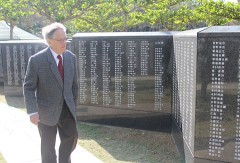
December 14, 2012, Ryukyu Shimpo
On December 13, Donald Keene, the famous 90-year-old scholar of Japanese literature, visited the Cornerstone of Peace in Itoman, offering prayers for the victims of the Battle of Okinawa. Keene participated in the battle as an interpreter for the U.S. military. He said, “Many civilians were killed unnecessarily. There are many reasons why armed conflicts occur, but choosing war is the biggest mistake we can make. It should never be repeated.”
Keene landed in Okinawa in 1945. He interrogated Japanese prisoners and appealed to Japanese soldiers to surrender. Keene said that he had a strong desire to rescue Japanese people, but many civilians firmly believed Japanese military propaganda that if they were captured by U.S. soldiers, women would be raped and children would be killed, so they opted to die as quickly as they could. The responsibility of the Japanese military in creating this situation is significant.
Keene is also concerned about the recent territorial disputes over the Senkaku and Takeshima Islands, and commented that all human beings are capable of negotiating, and so we should not make hasty choices on courses of action. He went on to say that peace should be something that all of mankind aspires to achieve and maintain.
(English translation by T&CT, Kyoko Tadaoka and Mark Ealey)
Go to Japanese
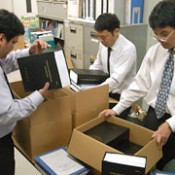
December 19, 2012 Ryukyu Shimpo
On December 18, the Okinawa Defense Bureau submitted to the Okinawa Prefectural Government (OPG) the revised version of the Environmental Impact Statement (EIS) about the relocation of U.S. Marine Corps Air Station Futenma to Henoko in Nago. With this, the government has now completed the requirements of the assessment procedure. On December 19, after confirming that there were no deficiencies in the document, the OPG accepted the revised EIS. The government will now apply to the Governor of Okinawa for approval of the Henoko landfill. The Okinawa Defense Bureau will give public notice and provide access to the EIS at five locations including the OPG office, Nago and Ginoza municipal offices and the Bureau office. This will occur over a one-month period, starting at the end of the year. Referring to the Okinawa Defense Bureau having submitted the revision of the EIS immediately after the election and before the inauguration of the new government, Okinawa Governor Hirokazu Nakaima said to the press, “This is quite unexpected.”
Although the government is able to apply for approval of the landfill before the end of the period of public release and perusal of the revised EIS, an official of the Ministry of Defense commented that normally this happens after the period of public notice. With regard to the effect of aircraft noise, in the revised EIS, a WECPNL (Weighted Equivalent Continuous Perceived Noise Level) value of 71.3 was recorded at the fishing port at Henoko. This figure exceeds the environmental standard because the noise prediction survey now covers the engine noise adjustment and hovering of all aircraft, including the Osprey, something that was not included in the previous EIS. The WECPNL values were higher than those in the previous EIS in all 15 locations in which the survey was conducted.
With regard to dugong, a recognized Japanese national treasure, the Ministry of Defense carried out a population viability analysis and calculated the probability of extinction for the dugong in 100 years. The report concluded that the difference between the extent of the risk of extinction due to the initial population of females and its reproductive rate was relatively large, but that there was no difference in the risk of extinction before and after the project being conducted.
Compared to the extent of the risk of natural extinction for the three dugongs that the Ministry of Defense has confirmed as existing in the area, the government underestimated the negative impact on the dugongs that face of extinction due to the construction project for the alternative facilities for the Futenma Air Station.
According to the OPG, at around 3:30pm, on December 18, about 20 staff members of the Okinawa Defense Bureau carried the revised EIS documents in about 20 boxes into the relevant sections of the OPG such as the Environmental Policy Division and the Coastal and Disaster Prevention Division. About 30 minutes later, Defense Bureau staff also delivered the documents to the Nago and Ginoza municipal offices. The Governor of Okinawa has submitted a statement of opinion, in which he concluded that protection of the environment would be impossible, pointing out that based on the laws and regulations of the Okinawa Prefectural Government there were a total of 579 deficiencies in the EIS. The next step will focus on how many of the points that the Governor of Okinawa suggested in his statement of opinion have actually been achieved in the new EIS.
(English translation by T&CT, Mark Ealey)
Go to Japanese
December 14, 2012 Ryukyu Shimpo
On December 13, Hiroshi Shimoji, the head of the Environmental and Community Affairs Department, Okinawa Prefectural Government (OPG), commented that he would strive to establish a “one-stop support center” to provide support for the victims of sexual assault. Shimoji was responding to a question from Kazuo Okuhira at a regular meeting of the Okinawa Prefectural Assembly. The OPG will carry out preliminary research in fiscal 2013, looking at similar projects set up in other prefectures, and hopes to start the center in fiscal 2014 after acquiring appropriate budget.
In preparation for its establishment, the OPG will consult with the Okinawa Women’s Foundation, the Rape Emergency Intervention Counseling Center-Okinawa, the Okinawa Prefectural Police Headquarters and the Okinawa Crime Victims Support Center “Yui,” and will organize a meeting to consider matters related to the establishment of the one-stop support center before the end of this fiscal year.
Yoko Kinjo and Mao Tanaka, co-leaders of the group who have pushed for the establishment of the center, have asked the Prefectural Assembly for it be set up as soon as possible. The request includes setting up a year-round 24 hour-a-day hot-line and locating the new center within a Department of Obstetrics and Gynecology in a general hospital. They also request cooperation from lawyers, psychiatrists and other specialists, support from the perspective of the people involved, public assistance to subsidize medical expenses for treatment, and for the OPG to contribute to the center’s operating costs.
(English translation by T&CT, Mark Ealey)
Go to Japanese

December 13, 2012 Ryukyu Shimpo
The Japan-based international non-governmental and non-profit organization the Peace Boat and a Korean environmental foundation co-hosted a tour designed to consider the burden on Okinawa of hosting U.S. forces in the prefecture. About 300 participants from outside of Okinawa, and from Korea, separated into six groups and looked at the U.S. Marine Corps Air Station Futenma and the Henoko district of Nago where the U.S. and Japanese governments plan to construct an alternative facility to Futenma Air Station.
The group that visited the observation tower at Kakazu Takadai Park to look at Futenma Air Station experienced military aircraft noise first hand. Kim Minjee from Seoul said, “I was surprised by the visit. Seoul has a U.S. army base, but we are not exposed to the dangers of potential crashes of military aircraft or noise. I do not understand why Japanese politicians do nothing about the base-related issues. Futenma Air Station is located in a densely populated area and this could result in great damage to the local community.” A participant from Osaka said, “I used to have just a vague idea of the U.S. military base issue, but actually coming here and seeing them frightens me. It is unfair that Okinawan people have to shoulder the heavy burden of U.S. bases. I will certainly tell people about this when I get back to Osaka.”
The group that visited the Henoko district of Nago went on a boat to look at the sea off Henoko. One of the participants said, “I completely oppose the plan to build a military base so close to such a beautiful place.” The participants in the group agreed to regularly visit Henoko and to conduct tours promoting opposition to the bases.
The co-leader of the Peace Boat, Shinsaku Nohira, said, “It is wrong for the Japanese government to expose the people of Okinawa to the risks that come with military bases. One of those risks is the flight operation of the MV-22 Osprey, which the government claims is safe. I think that the people who have visited Okinawa on this occasion will sense the reality that Okinawa that faces with the U.S. military base issues. Actually visiting the prefecture and hearing what Okinawan people have to say has made me understand the difference between the feelings of the Okinawan people and the people living in the main islands of Japan towards the base issue.”
(English translation by T&CT, Mark Ealey)
Go to Japanese
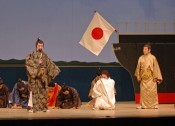
December 3, 2012 Ryukyu Shimpo
On December 2, at the Naha City Hall, the Ryukyuan historical play “Surrender of the Shuri Castle,” which depicts the annexation of the Ryukyu Kingdom by the Meiji government, was performed. According to the Okinawa Actors’ Association, this play had not been performed for about 24 years since the last time it was at the Hall in 1988. The hall was very crowded and some of the audience had to watch standing. This significant work depicting the history of Okinawa was very well-received by the audience.
The Naha Municipal Office, the Okinawa Actors’ Association, and the Ryukyu Shimpo cooperated in hosting the event to commemorate the 20th anniversary of the founding of the Naha City Culture Association.
The play tells the story of when the Meiji government ordered the abolishment of the Ryukyu han (feudal domain) and forced the surrender of Shuri Castle. A confrontation ensued between the pro-Japan party and the pro-China party. King Sho Tai’s farewell scene, in which he surrenders the castle and parts from his loyal followers, brought tears to the eyes of many in the audience.
Yukari Kudaka, a student of Shuri High School, said, “We aren’t taught about Ryukyuan history at school. I was really moved by the scene in which King Sho Tai surrendered.” Toru Tamaki from Itoman said, “I associated the story with contemporary Okinawa. I hope there will be more such historical performances.”
Photograph: The scene in which King Sho Tai (second from left) surrenders the castle and bids farewell to his loyal followers after receiving the order to do so from the Meiji government. December 2, at the Naha City Hall.
(English translation by T&CT, Megumi Chibana and Mark Ealey)
Go to Japanese

December 11, 2012 Ryukyu Shimpo
The non-profit organization Okinawa Senior Association has started a community cafe called Ji & Ba in Asato district of Naha in which the participants promote exchange activities in the local community through their own projects. On December 4, the association opened the Newspaper Cafe as its first project. Thirteen participants ranging in age from 30s to 70s enjoyed discussing news articles and finding unexpected common ground through intergenerational exchange.
Aiming to create workplaces for the elderly, the association launched Minna no Chikara LLC and has been working on production and distribution of a lunch bag product. The association started a community cafe by leasing its kitchen and conference room to provide opportunities for the elderly and people of different generations to achieve what they want to do.
The association intends to sell handcrafted accessories and hold various workshops or events such as One-Day Chief, in which participants can become the cafe manager for a day.
In the Newspaper Cafe, Yukiyo Zaha, a reporter of the Ryukyu Shimpo who promotes the Newspapers in Education program, explained newspaper design, and the participants attempted to put together headlines. The participants divided themselves into groups, creating their own newspapers made up of articles they liked, and gave presentations about them. The participants enjoyed the company of other people creating their own newspapers.
Sixty-nine year-old Naha resident, Tamiko Higa, said, “This was the first time since I was at elementary school that I have cut out newspaper clippings and put articles together like this. I really enjoyed myself because the participants in a wide age range made me feel that the atmosphere in the cafe was open.” Thirty-seven year-old Naha resident, Shinpei Fukaya, said, “It was a great experience which made me realize that there are various viewpoints on things.”
The Newspaper Cafe is scheduled to be held every Tuesday. The executive director of the association, Tomoko Imaki said, “I was again amazed that the newspaper could make men and women of diverse occupations and ages, read articles and exchange opinions.”
For further details, call the Okinawa Senior Association at 098 (868) 7237, or access its blog at http://seniorlife.ti-da.net/.
(English translation by T&CT, Mark Ealey)
Go to Japanese
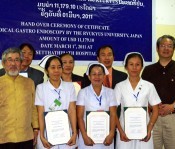
December 15, 2012 Ryukyu Shimpo
This year marks ten years for the University of the Ryukyus Hospital since it began to teach practical guidance and knowledge of digestive endoscopy in Laos in January 2002. Fukunori Kinjo and Nagisa Kinjo, doctors of the Department of Endoscopy, University of the Ryukyus Hospital, have visited Laos and provided support for local medical staff. Thanks to Japanese endoscopic technology, which is said to be the best in the world, the number of check-ups has increased dramatically and medical treatment using endoscopy at local hospitals in Laos has become possible for the likes of gastric ulcers or esophageal varices.
Initially, the University of the Ryukyus Hospital sent a doctor to participate in the hospital improvement project run by JICA at the National Setthathirath Hospital in Vientiane, Laos. After that, for several years, it sent doctors sponsored by the Ryukyu Asia-Pacific Medical Exchange Association. However, after the term of the grant ended, in 2008 and 2011 Nagisa Kinjo and Fukunori Kinjo stayed on for a week to support activities at their own expense. The University of the Ryukyus Hospital has also extended its activities to local hospitals such as Luang Prabang Hospital in Northern Laos.
In the early stages there were complaints from patients because medical staff conducted endoscopic inspections without using sedation or pharyngeal anesthesia. Doctors from the University of the Ryukyus provided advice, including confirmation of procedures, which drugs should be used for patients, how to interpret endoscopic images and how to fill in medical records. Nagisa Kinjo thinks that the support activities have been useful, saying, “The local staff have obtained skills and knowledge on medical services, and their patients are very grateful for this. They are tenacious and ambitious and this makes us want to help.”
On October 20, Koeopasuth Phyvanh, a doctor from Sethathirath Hospital, visited Okinawa. For about one month he learned about the examination and treatment of gastrointestinal endoscopy at University of the Ryukyus Hospital and other hospitals in the prefecture. The support project has evolved into genuine exchange between Okinawa and Laos. They now operate a system of cooperation in which staff at hospitals in Laos send paper images and endoscopic findings to the University of the Ryukyus Hospital for Fukunori and Nagisa Kinjo to check their findings. Fukunori Kinjo said, “Our support activities will come to an end at some stage, but if the local staff in Laos such as doctors and nurses are able to educate their colleagues, they will be able to then make a significant contribution to the level of health check cares in Laos. We want to continue to provide support until they can create an environment in which they are independent in terms of medical care.”
(English translation by T&CT, Mark Ealey)
Go to Japanese

December 5, 2012, Ryukyu Shimpo
On November 30, in the national forest in Taira, Higashi-son the Shuri Castle Forest Development Council, which has been carrying out an afforestation project, planted 300 inumaki (Podocarpus macrophyllus) trees to use in restoring the castle to its former glory. About 60 people, including members of the council, officials of Higashi Municipal Office and fourth grade pupils of Higashi Elementary School helped with the planting.
The council has been already working on an afforestation project at Aha in Kunigami, planting trees such as inumaki and iju (Schima liukiuensis Nakai), which are used in Okinawa traditional buildings and crafts. The planting in Higashi-son was part of their extended activities.
A total of 400 iju trees were planted in the 0.68 hectare forest. They are going to plant Okinawa urajirogashi trees (Quercus miyagii) next year. The council will cooperate with locals and volunteers to look after the plantation. After the planting, Noa Higa, a pupil of Higashi Elementary School said, “It was hard work, but I had fun planting the trees. I hope that they will grow bigger and in future be used for the renovation of Shuri Castle.”
(English translation by T&CT, Kyoko Tadaoka and Mark Ealey)
Go to Japanese
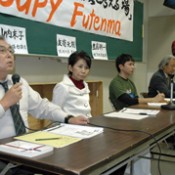
December 9, 2012 Ryukyu Shimpo
On December 8, at Okinawa International University in Ginowan members of the citizens’ group “Occupy Futenma” held a symposium entitled “Thinking about the September 30 Futenma Air Station gate blockade action.” Looking back at the protest action carried out almost three months ago against the Osprey deployment, members of the group who were actually there and participants on the floor discussed what the nature of the peace movement should be as it moves forward. Some new approaches were suggested, including working together with people involved in the anti-nuclear power movement.
Pointing out the current situation in which the movement to amend the constitution has come out into the open, Hiroji Yamashiro, the secretary-general of the Okinawa Peace Movement Center, stated, “What we managed to do at Futenma is highly significant.” He also touched on the issue of nuclear power, saying, “Our voices should continue to be heard from Okinawa. I think that we can join forces with other victims of government bullying.” Peace activist Yamashiro called for the movement to display a dignified attitude and have strong ambitions, saying, “The Okinawan movement has given hope to people all across the country.”
With regard to the incident that occurred in front of the gate of the Futenma Air Station on September 30 in which the police removed protesting citizens from the scene to stop the blockade, lawyer Shunji Miyake commented, “There is no legal basis for the police using their authority to remove citizens.” Sueko Yamauchi, the member of the Okinawa Prefectural Assembly who pursued this issue at a regular meeting of the Assembly, reported on the interaction between her and Okinawa police chief Takashi Murata. Motoki Tomoyose, a student of the University of the Ryukyus, explained the event called “Night Picnic” that student groups held in the square near Oyama Gate to protest against the rape of a local woman by U.S. sailors. They used a new form of resistance in which participants exchanged views under candlelight, deciding against using banners or shouting out in chorus.
(English translation by T&CT, Mark Ealey)
Go to Japanese

December 9, 2012 Ryukyu Shimpo
On December 8, Himawari, a movie about the incident in which a U.S. F-100 fighter from Kadena Air Base crashed onto Miyamori Elementary School in Ishikawa, killing 18 pupils on June 30, 1959, premiered in packed theaters in Uruma and Naha. The people in the audience seemed to cast their minds back to that time, thinking about how precious life and peace are. They appeared to once again acknowledge the significance of continuing to talk about the incident. The movie is scheduled to be screened in other parts of Okinawa from next January.
In the movie, the protagonist experiences the U.S. military helicopter crash onto Okinawa International University and remembers the tragedy of Miyamori Elementary School that he had experienced in the past, causing him to anguish over the fact that the situation is unchanged.
The pre-release in Uruma was held at Ishikawa Hall, which is located near Miyamori Elementary School in the Uruma district (photograph).
The movie is based on fact and was recreated using images that have a tremendous impact on the audience, who were glued to the screen as they relived the tragic events of the past. Some shed tears thinking of the tragedy that shattered people’s peaceful everyday lives in a split second.
Sixty-three year-old Nago resident Yoriko Kise said, “It made me appreciate being alive. I would like to bring my family to see the movie.”
Mitsuteru Toyohama, who actually experienced the accident, and is also the head of the Ishikawa and Miyamori 630 Association that collected the statements from people who witnessed the accident on which the movie was based, said, “The movie succeeded in describing the current situation in Okinawa, and also in describing the regret we felt in not being able to save the pupils.” Toyohama called for many people to come to see the movie, saying, “I want the movie to help to remove the MV-22 Osprey aircraft from Okinawa, and to consolidate and scale down the U.S. military presence in our prefecture.”
(English translation by T&CT, Mark Ealey)
Go to Japanese

December 6, 2012 Ryukyu Shimpo
The Okinawa Convention & Visitors Bureau participated in the Europe Incentive, Business Travel & Meetings Exhibitions (EIBTM) 2012, a type of business expo known as MICE (Meeting, Incentive, Convention, Exhibition) held from November 27 to 29 in Barcelona. Out of a desire to increase the number of inbound international visitors, they set up an independent Okinawan booth at the event for the first time. They also held the first Okinawa business seminars in Taiwan from November 26 to 29 in Taipei, Taichung, Tainan and Kaohsiung.
The EIBTM is the largest business exhibition in Europe, and following on from last year this was the second time that the Okinawa Convention & Visitors Bureau participated. In addition to the Bureau, DMC Okinawa and Mercure Hotel Okinawa Naha also operated booths in order to attract and hold seminars and meetings. They had a total of 82 business talks and there were several inquiries about holding international conferences on science and technology related topics and attracting wedding trips to Okinawa.
At the seminar in Taiwan, the Okinawa Convention & Visitors Bureau explained the points of attraction about Okinawa and its related facilities. Four companies participated from Okinawa including JTB Okinawa and the Southern Beach Hotel & Resort, and 279 people from 180 Taiwanese companies, such as travel companies that deal with MICE, visited the event.
By the April to November period this year the Bureau had supported and held a total of 202 MICEs domestically and overseas. Among them, 86 were international conferences, and 116 were rewards and study tours.
A representative of the OCVB said that Europe is a new market and they would like to attract their people to the MICE in the future, and also stressed that the number of Chinese visitors to Japan has not increased because of the territorial dispute over the Senkaku Islands (Diaoyu Islands). Taiwan deals with many tours to Japan and has become a significant market for Okinawa in recent times. They hope that in future not only Taipei but also other regional cities will participate in the MICE.
(English translation by T&CT, Lima Tokumori and Mark Ealey)
Go to Japanese










 Webcam(Kokusai Street)
Webcam(Kokusai Street)


